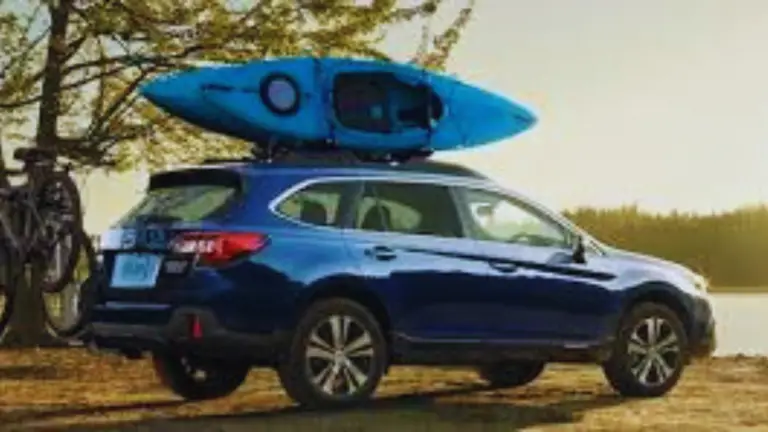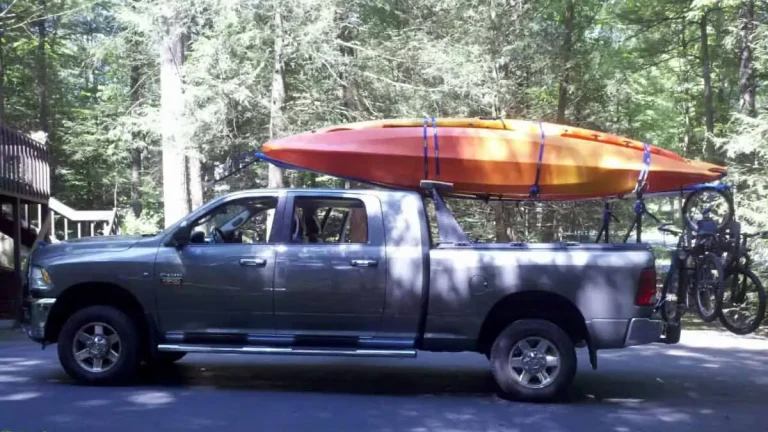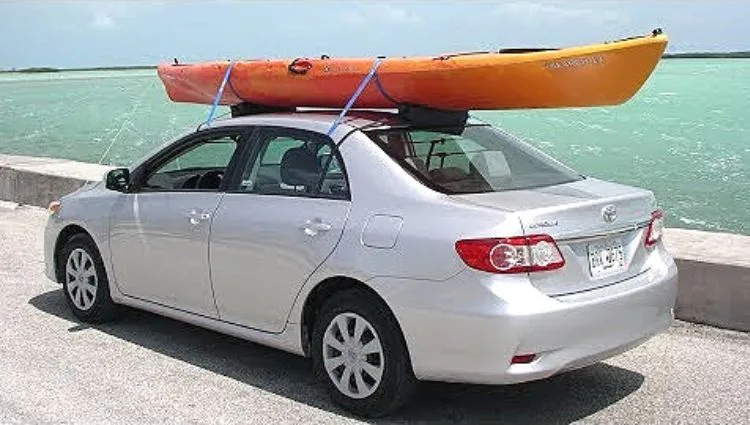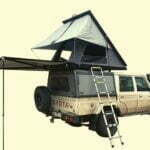Although kayaking is a fun way to travel about and discover new rivers, the boats themselves are sometimes bulky and awkward to transport. It’s not that hard to find the best Kayak rack for car without roof rack and install it yourself.
Fortunately, you can acquire a kayak rack for a car without a roof rack. There are a few things to keep in mind while shopping for the finest kayak roof rack.
To assist you choose the finest kayak roof rack for your needs, we’ve compiled a list of the most often asked questions along with our seven top recommendations. We’ll go through some things to think about and options to think about before making a purchase.
If you want to go kayaking but have to bring your kayak with you, don’t worry. Finding the finest kayak roof rack for cars without rails might be difficult, but you can get the one you need right here.
Table of Contents
ToggleWhy You Need A Kayak Rack For Your Car
If you enjoy spending time outdoors kayaking, then you need a reliable rack to transport your kayak from one location to the next. A kayak rack for your car is the perfect solution. There are many different types of kayak racks available on the market, so it is important to choose the one that best suits your needs.
The most important consideration when selecting a kayak rack is whether or not you have a roof rack already installed on your car. If you do not have a roof rack, then you will need to choose a Yakima J-Rack or similar type of rack carrier that mounts directly onto your car’s frame. These types of kayak racks are very affordable and easy to install.
If you do have a roof rack, then you have a few more options available to you. You can choose between a soft-sided carrier or a hard-sided carrier, depending on your preference. Hard-sided carriers offer more protection for your kayak but can be more difficult to load and unload. Soft-sided carriers are easier to use but do not offer as much protection.
Another important consideration is the size and weight of your kayak. Not all racks are designed to accommodate all sizes and weights of kayaks, so it is important to check the specifications before purchasing.
Once you have considered all of these factors, you will be able to narrow down your choices and select the best Kayak rack for car without roof rack system.
Kayak Rack for Car Without Roof Rack - Comparison
Malone Downloader Folding J-Style
Our ratings
- Dimensions: 21 x 10 x 8"
- Weight: 10 lbs
- Load capacity: 75 lbs
- Compatibility: Universal
Rhino-Rack Nautic 570 Series
Our ratings
- Dimensions: 10 x 7 x 6"
- Weight: 6 lbs
- Load capacity: NA
- Compatibility: Universal
Thule Hullavator Pro 898
Our ratings
- Dimensions: 21 x 10 x 8"
- Weight: 40 lbs
- Load capacity: 75 lbs
- Compatibility: AeroBlade, SquareBar
Malone SeaWing
Our ratings
- Dimensions: 28 x 8 x 6"
- Weight: 10.5 lbs
- Load capacity: 70 lbs
- Compatibility: Universal
Yakima JayLow J-Cradle
Our ratings
- Dimensions: 20.3 x 10.4 x 7.8"
- Weight: 1.3 lbs
- Load capacity: 110 lbs
- Compatibility: Round, square, factory, and aerodynamic crossbars.
HandiRack Universal Inflatable
Our ratings
- Dimensions: 14.6 x 7.4 x 5.7"
- Weight: 6.4 lbs
- Load capacity: 175 lbs
- Compatibility: Universal
Attwood Universal Foam
Our ratings
- Dimensions: 20 x 8 x 6"
- Weight: 1.6 lbs
- Load capacity: Dependent on car roof capacity
- Compatibility: Universal
Malone VersaRail
Our ratings
- Dimensions: 50 x 8 x 5.75"
- Weight: 10.5 lbs
- Load capacity: 135 lbs
- Compatibility: Universal
Seah Hardware
Our ratings
- Dimensions: 47.6 x 4.8 x 3.2"
- Weight: 6 lbs
- Load capacity: 150 lbs
- Compatibility: Universal
Kayak Rack for Car Without Roof Rack - Review
1. Malone Downloader Folding J-Style Universal Car Rack Kayak Carrier

You can easily load your kayak onto the roof of your car with the aid of the integrated boarding ramp included on the Malone Downloader Folding J-Style Universal Kayak Car Rack.
Padding on the Malone rack is extra thick, protecting the kayak from bumps and scrapes. The kayak may be loaded and unloaded more easily with the aid of the ramps.
In addition, the JAWZ mounting hardware is adaptable and may be used with either round, oval, or square cross rails.
The racks come with cam-style load straps and pre-coated mounting bolts in both 60 and 70 millimeter diameters. Additionally, it protects your kayak’s buckles from wear and tear.
The Malone Downloader racks are quieter than other J-style cradles and can be folded flat when not in use. When they are lowered, the wind does not make any audible noise.
As an added bonus, the JAWZ mounting hardware is adaptable to both round and oval cross rails in addition to the more standard square ones.
The rack comes with cam-style load straps and pre-coated mounting bolts in both 60 and 70 millimeter diameters. Additionally, it protects your kayak’s buckles from wear and tear.
In contrast to the bulky and often loud J-style cradles, the Malone Downloader racks may be folded flat when not in use. When they are lowered, the wind does not make any audible noise.
What we like
- Made to fit any standard mounting pattern.
- The ramps make it simple to load and unload the kayak.
- Extra cushioning provides increased safety.
- When not in use, you may simply fold it up.
What we don't like
- Large fishing kayaks cannot access this area.
2. Rhino-Rack Nautic 570 Series Kayak Rack

Most types of kayak roof rack crossbars are compatible with the Rhino-Rack Nautic 570 Kayak Roof Rack. The front and rear cradles are adjustable to accommodate a variety of hull sizes and shapes. You may choose between a side-loading version and a rear-loading version of this model.
There are two rubber pads on the front of the carrier to prevent scratching or denting your kayak. A pair of cushions in the back are spring-loaded. If you choose the rear-loading version, the pads at the back are likewise coated with felt for easy loading of the kayak.
Everything you need to get underway is included with the Rhino-Rack 570 kayak rack. Rack, cradles, key, tie-down straps, and assembly instructions are all included in the box.
Although these are excellent, the Rhino-Rack Nautic 570 kayak racks are better suited to transporting several kayaks. We suggest a J-cradle design, such as the Malone Downloader, if you own two big kayaks and want to transport them on your car’s roof.
What we like
- Works with most universal car roof rack pad.
- There are pads in front and back that help keep the kayak in place.
- It comes with everything you need to set it up and start using it.
- Mold, water, and UV rays don't hurt it.
What we don't like
- With aero crossbars, it doesn't work as well.
3. Thule Hullavator Pro 898 Kayak Rack System

The hulls of kayaks up to 36 inches wide and 75 pounds in weight are no problem for the Thule Hullavator Pro 898 Kayak Lift System’s roomy cradles.
If you drop the kayak 40 inches down the side of your truck, you’ll have plenty of room to load, unload, and secure your kayak. The kayak’s gas struts make transporting and stowing it a breeze.
Because of the carrier’s strut system, the Kayak only weighs about half as much as it would without it, making it possible to transport it alone.
In addition to the quickdraw bow and stern tie-downs, the two center straps provide even more stability for your kayak when it is being transported on the roof of your vehicle. As an added safety feature, it features buckled bumpers to prevent damage to vehicles.
In addition, the Thule 898Pro has 8 touchpoints of cushioning to safeguard your kayak. This type of roof rack comes with corrosion-resistant base and cradles.
The Thule Hullavator Pro is a bit pricy, but if you’re looking for a carrier that will do a lot of the hard work for you, it shouldn’t let you down.
What we like
- At waist level, it's easy to load.
- The gas struts make it much easier to load and unload the kayak.
- The base and cradles are resistant to rust.
- Setup is really easy and quick.
What we don't like
- Pricey
4. Malone SeaWing Kayak Roof Rack

Malone SeaWing Kayak Carrier is an excellent choice if you need a roof rack for your kayak that doesn’t take up too much room. It is easy to assemble because of its single-saddle design.
The kayak may be mounted midway, saving valuable real estate on your car’s roof. It bends just enough to snugly hold the kayak in place.
Our favorite feature is its adaptability to various crossbar sizes and materials. All shapes and sizes of round, oval, and square cross rails may be securely mounted with the included hardware. You may also find two bow and stern lines, a 15-foot-long cam buckle strap, and a user handbook in the package.
It can hold a kayak up to 70 pounds and measures 27″ in length, 5″ in width, and 6″ in height.
What we like
- Rack is made in a unique mid-mount style.
- Saves up space.
- Universal JAWZ mountable hardware rack that fits most cross rails.
- Setup is really easy and quick.
What we don't like
- Not appropriate for large kayaks.
Best Kayak Roof Rack For 2 Kayaks
5. Yakima JayLow J-Cradle Kayak Roof Rack

A single kayak, up to 80 pounds in weight, may be stored in the J-cradle. However, the two cradles can be mounted together by stacking them vertically. The total load of both kayaks shouldn’t be more than 110 pounds.
The rack is compatible with the Yakima streamline and several other square, oval, and round crossbars, while requiring a minimum crossbar spread of 24 inches.
This kind of kayak rack is complete with all necessary hardware for mounting on a roof. Heavy-duty straps, bow and stern tie-downs, and the Same Key System are all part of the bundle (SKS). Extra padding is included at all points of contact with the rack to protect your kayak from damage.
These rack accessories will keep your kayaks from toppling off the roof of your car while you’re on the road.
The kayak’s built-in cam lever allows you to modify how upright the seat is. When not in use, the rack may be folded flat.
The Yakima JayLow Kayak rack is preassembled and ready to use. Simply remove it from its packaging and slip it on. It just takes around 10 minutes to set up and doesn’t require any special tools.
What we like
- It can simultaneously hold two kayaks.
- To protect your kayak, the contact points are cushioned.
- The SKS Lock allows the base rack to be secured.
- The rack is prefabricated.
What we don't like
- A bit expensive.
Rack Free – Kayak Roof Racks for Cars Without Rails
6. HandiRack Universal Inflatable Roof Rack Bars

The Malone HandiRack Universal Inflatable Kayak Roof Rack is versatile and easy to use with a variety of kayaks, canoes, and SUPs.
The HandiRack Universal Inflatable Kayak Roof Rack transports completely inflatable kayaks. It has two inflatable bars that you can clip to the top of your car to protect your kayak while driving.
The HandiRack’s adjustable straps run through your car’s interior to secure it, similar to other kayak racks for cars without roof racks. Inflate the rack using the provided pump. After that, the rack can hold 175 pounds of stuff.
The HandiRack’s compactness is a major asset. Bow and stern lines are included to fasten your kayak to your car. HandiRacks fit most cars, even 2-door sedans.
The HandiRack is adaptable, but it drags and makes noise at high speeds, making it unsuitable for lengthy road journeys. Due to its modest width, it can carry one kayak. Despite these drawbacks, the HandiRack is a cheap and adaptable kayak carrier.
What we like
- Fits most cars.
- Stores compactly.
- Easy installation.
- Secure bow and stern lines.
What we don't like
- Highway drag and noise.
- Transports one kayak.
7. Marine Roof Rack Pads

The Best Marine Kayak Roof Rack Pads are foam blocks, and they are the most cost-effective and hassle-free option for transporting kayaks.
The finished kayak rack system from Best Marine. It consists of two foam pads secured with nylon straps that can be adjusted to fit any automobile top. A pair of ratchet tie-down straps, anchors for the trunk and roof, and an auxiliary wire for the tow hooks and stern line are all included.
Quickly and easily attach this Best Marine rack to your car by running the straps of the 48′′ foam roof bars through your vehicle. You may then attach your kayak to the rack by using the ratcheting straps and steep D-rings on the foam cushions. You can easily secure kayaks of varying widths to your car with these D-rings.
Marine grade foam blocks are used to make the best roof rack cushions available. They are built to last with 600D polyester fabric and shock-absorbing EPE foam.
These foam blocks, however, are not suitable for use in vehicles with only two doors. Due to their lack of stability at high speeds, they are best suited for usage as a means of local kayak transportation. Despite these drawbacks, the Best Marine Kayak Roof Rack Pads are among the most reasonably priced and useful kayak racks.
What we like
- Bow, stern, and trunk anchors.
- Steel, foam, and durable textiles.
- Installs quickly.
- Cheap.
What we don't like
- Not for 2-door cars.
- Use cautious on high-speed highways.
8. Attwood Universal Foam Kayak Roof rack

There’s no need to install a roof rack or crossbars on your car when you have an Attwood Universal Rack Free Foam Kayak Roof Rack. Everything you need to transport your kayak securely is included in this package, making it an excellent buy.
As the name implies, the package comes with foam blocks for supporting the kayak while it’s being transported on the vehicle’s roof. The kayak is safe and sound on the car’s roof thanks to these foam blocks.
A polypropylene rope of 15 feet in length secures the kayak to the top of the vehicle. The two included straps are fully adjustable with buckles and clips, so they may be used with kayaks of varying widths.
We conclude that the Attwood rack-free kayak carrier offers excellent value for the price. It’s a fantastic substitute for a kayak rack and roof rack if you’re strapped for cash but still need to transport your watercraft.
What we like
- Kayaks above rooftops are stabilized by foams.
- The 15-foot polypropylene rope secures the kayak to the car's roof.
- Kayak loading and unloading is simple.
What we don't like
- The foam flattens after a few usage.
- Weak straps.
Best Non-Permanent Roof Rack For Cars Without Roof Rack
9. Malone VersaRail Roof Rack

Malone has introduced a fantastic new kayak vehicle rack to the market. This naked roof can be transformed into a functional rack with the help of the Malone VersaRail Bare Roof Cross Rail Rack. It’s useful for hauling luggage boxes, as well as kayaks, motorcycles, and canoes.
About 135 pounds is the utmost acceptable load. Because of its rectangular design, it can accommodate the vast majority of rack attachments.
There is no special equipment needed to set up the VersaRail. In order to use this, a wrench is required, however one is supplied. The manufacturer even provides a five-year guarantee, which is fantastic.
For vehicles without rails, we recommend the Malone VersaRail. Using j-bars, we experienced zero complications. The racks’ flexibility in terms of installation and removal is a major plus for us.
The rain will leak down the straps and into your car if you keep them on for a long time in the rain. That so, it is to be expected that cloth straps will stretch with time.
If you know rain is on the way and don’t plan to use the racks, it’s best to take them down before it starts.
What we like
- Durable non-corrosive coating.
- Installs easily.
- Robust.
What we don't like
- Heavy rain might leak through the straps inside the car.
10. Seah Hardware Universal Roof Rack For Car Without Rails

The Seah Hardware Universal Roof Rack Cross-Bars are great for vehicles without rails. Waterproof ratchet tie-downs can hold up to 1800 pounds, so you can rest assured that the roof bars will stay put in your vehicle.
A pair of sturdy steel tubes measuring 48 inches in length are included with the Seah Hardware Roof Rack. Generally, it can accommodate any 4 door vehicle without a sunroof.
This roof rack fits on most vehicles with current rails, but if your rails are taller than 6.4cm, it won’t work with your vehicle. There isn’t enough room between the bars for freight, and thus it can’t be fitted on two-door vehicles either.
In conclusion, this Seah Hardware Universal Roof Rack is fantastic. This rack may be used to carry a variety of items, including a kayak, a mountain bike, a ladder, and more.
What we like
- Durable non-corrosive coating.
- Installs easily.
- Robust.
What we don't like
- Heavy rain might leak through the straps inside the car.
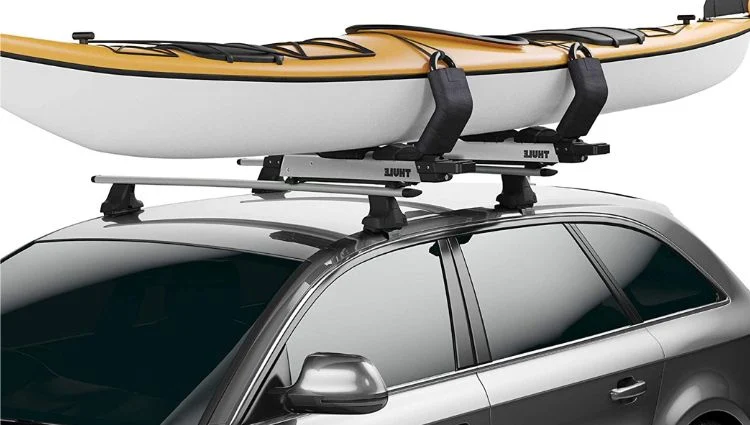
Buying Guide: Kayak Rack For Car Without Roof Rack
We discuss kayak roof racks for cars with and without rails, as well as the features to look for when making your purchase. We also address some of the most frequently asked issues regarding rail-free kayak roof racks.
There are essentially four distinct varieties of kayak roof racks available. This includes:
J-Cradle kayak carrier
A J-cradle kayak rack is mounted at an angle of 45 degrees. Your kayak will be safe and sound on this rack, which is designed to fit on top of a roof rack. Further, it provides sufficient room for two kayaks to be stowed away safely and securely on the carrier.
Paddle Stacker
Stacker kayak racks can handle anywhere from two to four kayaks at once. People going on a kayaking vacation or with a large family will find this roof rack to be an indispensable accessory. In addition to your kayaks, you can also stow your bags on the roof.
The kayaks are fastened vertically, which is not optimal when considering aerodynamics.
Temporary Padding
Cushioning the kayak with some temporary padding is one of the quickest ways to fix a roof rack for kayaks. Inflatable or foam pads make up this system. These pads can be easily attached to your car roof anytime you need them.
In the event that you have been unable to locate a roof rack that will suit your particular car, this is the best option. These kayak roof racks are convenient, and they can be removed if you decide you don’t like having a permanent roof rack.
However, as their names imply, foam racks and inflatable racks are not a permanent answer.
Kayak Carrier Saddle
The automobile rack is one of the most popular ways to transport a Saddle Kayak. This style of rack is popular since it can be used quickly and easily. You can also be certain that your kayak will be safely fastened to the vehicle’s roof with this accessory.
Rather than vertically, the kayak is laid out on a rack. It won’t completely hog the roof of your car, leaving you with plenty of room for other cargo.
With regards to aerodynamics, this is also a secure position to hold. The risk of your kayak and gear falling off the roof during transit will be minimal.
Considerations Before Buying a Kayak Rack for Car Without Roof Rack
If you’re looking for a kayak rack, it’s important to consider your specific demands before making a purchase. You may use foam blocks, inflatable tubes, or metal crossbars to mount a kayak rack on the roof of a car without rails.
Foam Blocks
Strap-on kayak carriers made of foam blocks are readily removed from the car top. Load your kayak onto the foam blocks, secure it with the straps, then load it into your car. Make sure your kayak is properly fastened before you set off.
If you don’t want to permanently attach anything to your car, purchasing foam block racks is a fantastic option. They’re not only long-lasting, but cheap as well. The drawbacks of using foam blocks to transport kayaks are that you are limited to transporting a single kayak at a time and that you cannot go at high speeds.
Inflatable Tubes
Similar to how foam blocks attach to the roof of your automobile, inflatable tubes also use a strap system. When not in use, just deflate and store them away. Although they don’t take up much room, they are more pricey than foam blocks.
Care must be taken with these kayak racks because of their inflatable nature. Like any inflatable object, they are susceptible to tearing or developing holes. As a benefit, they will protect your kayak from bumps and scrapes.
Metal Crossbars
If you need a kayak rack for a car without rails, the most money will go toward a model with metal crossbars. They mimic factory-installed roof rails in appearance but need DIY installation.
Metal crossbars that either screw or strap into your car’s roof are commercially available. Although drilling provides more safety, this method is irreversible. Straps make it safe enough to travel with your kayak in your car, and you can even bring numerous kayaks with you if you have the space.
Storage Size
Mounts are not included with rock climbing racks for vehicles, in contrast to roof racks. The weight of them would be too much for your car, so you shouldn’t leave them on for extended periods of time.
Investing in a kayak rack is a simple and inexpensive solution for transporting your kayak on the car’s roof. Therefore, while shopping for a rack, you should think about how much room it will need when not in use. Is there sufficient room in the house? It’s not something you can just leave in your car when you’re not using it, so you’ll need somewhere to put it while it’s not in use.
Roof Rack’s Weight
The weight of a product is typically correlated with its perceived durability. Nothing could be further from the truth!
Steel racks tend to be somewhat heavy, but aluminum racks can save you anywhere from 20 to 30 percent in shipping weight. These roof racks made of aluminum are as strong as steel ones, if not stronger.
On top of that, they’re just as sturdy as the originals. For this reason, you need first determine how much weight your car’s roof can support, and then select an appropriate roof rack.
A roof rack made of metal is not required. Foam or inflatable roof racks cost hardly any more than a few pounds, so you always have that option.
Cost
Remember first and foremost that price is NOT an indicator of quality when shopping for a Kayak Roof Rack.
The price of many roof racks may add up quickly. A cheaper kayak with the same specs may be found with a little digging.
For this reason, it is important to examine the characteristics (and not the price) of different kayak roof racks before making a purchase.
Mounting System
Mounting systems should be carefully considered at all times. There are a variety of screw bracket systems and orientations for use with various racks. Some roof racks are designed to remain in place permanently, while others require removal after each usage.
In addition, the bracket’s layout determines how the kayak will be placed on the rack. You should first decide on a mounting system you want, and then search for roof racks that use that system.
Durability
Given its heavy workload and exposure to the elements, the rack is certain to suffer wear and tear over time. Furthermore, the quality and longevity of the roof rack might be impacted by the frequent loading and unloading of a kayak.
To that end, you should always inspect the roof rack’s construction. A protective coating is essential to extending its life and should be applied. In conclusion, check the warranty’s coverage period.
How To Store Your Kayak When Not In Use
If you have the room in your garage, consider storing your kayak on racks specifically designed for this purpose. Garage storage racks come in many different styles, but they all have one thing in common: they will keep your kayak off the ground and away from things could damage your kayak.
If you don’t have a lot of space in your garage, or if you simply don’t want to store your kayak there, you can also purchase freestanding racks that can be placed anywhere in your yard or patio. These are a great option if you want to be able to grab your kayak and go without having to lug it through the house first.
Another storage option is to invest in a kayak cover. Kayak covers come in a variety of sizes and styles to fit any type of kayak, and they will protect your investment from the elements when not in use. Be sure to measure your kayak before purchasing a cover, as some models are designed to fit specific types and sizes of kayaks.
Finally, if you live in an area where severe weather is common, it’s always a good idea to keep your kayak stored indoors when not in use. This will protect it from high winds, heavy rains, and even hail storms. If you don’t have a lot of space indoors, there is a need to consider renting a storage unit specifically for your kayak – many self-storage facilities offer climate-controlled units that are perfect for this purpose.
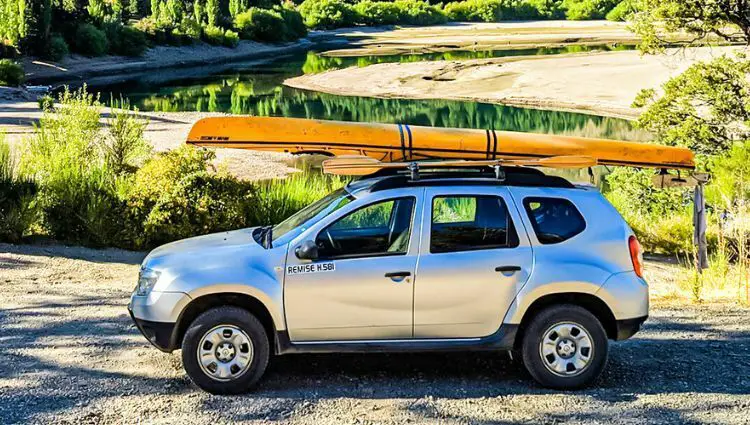
Kayak Rack for Car Without Roof Rack - FAQs
Q. What is the best kayak rack for car without roof rack?
There are a few things to consider when looking for the best kayak roof racks. First, consider the weight and size of the kayaks you will be carrying. You will need to find a rack that can accommodate the size and weight of your kayaks. Second, consider the type of vehicle you have. Some roof racks are designed for specific types of vehicles. Third, consider your budget. There are many different types of kayak roof racks available, so you will need to find one that fits your budget.
Q. What is the best way to transport a kayak in a car?
If you need to transport a kayak, you will need to have a way to secure it to your vehicle. You can use straps or rope to tie it down, and you will also need to make sure that the kayak is properly balanced on your vehicle.
Q. How do I choose the right kayak rack for my car?
When choosing a kayak rack for your car, consider the type of vehicle you have, how often you plan on using the rack, and how many kayaks you need to transport.
Q. How many kayaks fit on a roof rack?
This is another factor that is very dependent on the specific roof rack you choose. Although some roof racks can only hold one kayak, others can easily accommodate up to four.
From a single-kayak roof rack to a four-kayak rack, you’ll find it all in the products listed above.
Q. Do roof racks affect fuel economy?
An accurate method for determining whether or not a roof rack reduces gas mileage does not exist. The fuel efficiency of a vehicle may be affected by a variety of things, including the type of engine it has and the number of passengers riding within.
The rolling resistance of the tires, the surface you’re traveling on, the wind resistance, and many other elements all play a role.
However, wind resistance is a problem that might impact fuel usage while transporting a kayak on the roof rack. An increase in air resistance caused by a roof rack might cause the engine to work harder, resulting in increased fuel consumption.
Both the engine size and the quantity of kayaks in the cargo hold can have an impact on fuel efficiency. The addition of a Kayak roof rack might significantly affect the fuel economy of a small car, but it could not have much of an effect on a bigger vehicle.
The amount of gas your automobile needs during a trip can be affected by numerous things, not just the kayak roof rack.
Kayak Rack for Car Without Roof Rack - Final Thoughts
Any paddler worth their salt knows the importance of investing in a good kayak rack. This is especially important if your automobile doesn’t already have roof rails installed.
The Malone VersaRail Bare Roof Cross Rail Rack is, in our opinion, the finest kayak rack for cars without rails among the versions we’ve examined. Because it is adaptable to a wide variety of vehicles and comes in a variety of sizes, the VersaRail makes it easy to bring along more than one kayak on your travels. Our pick for the best kayak is Malone VersaRail.
Still, there is no universally ideal kayak rack. We really hope this information was helpful in your search for the ideal kayak roof rack. We’ll look for you out on the sea!

